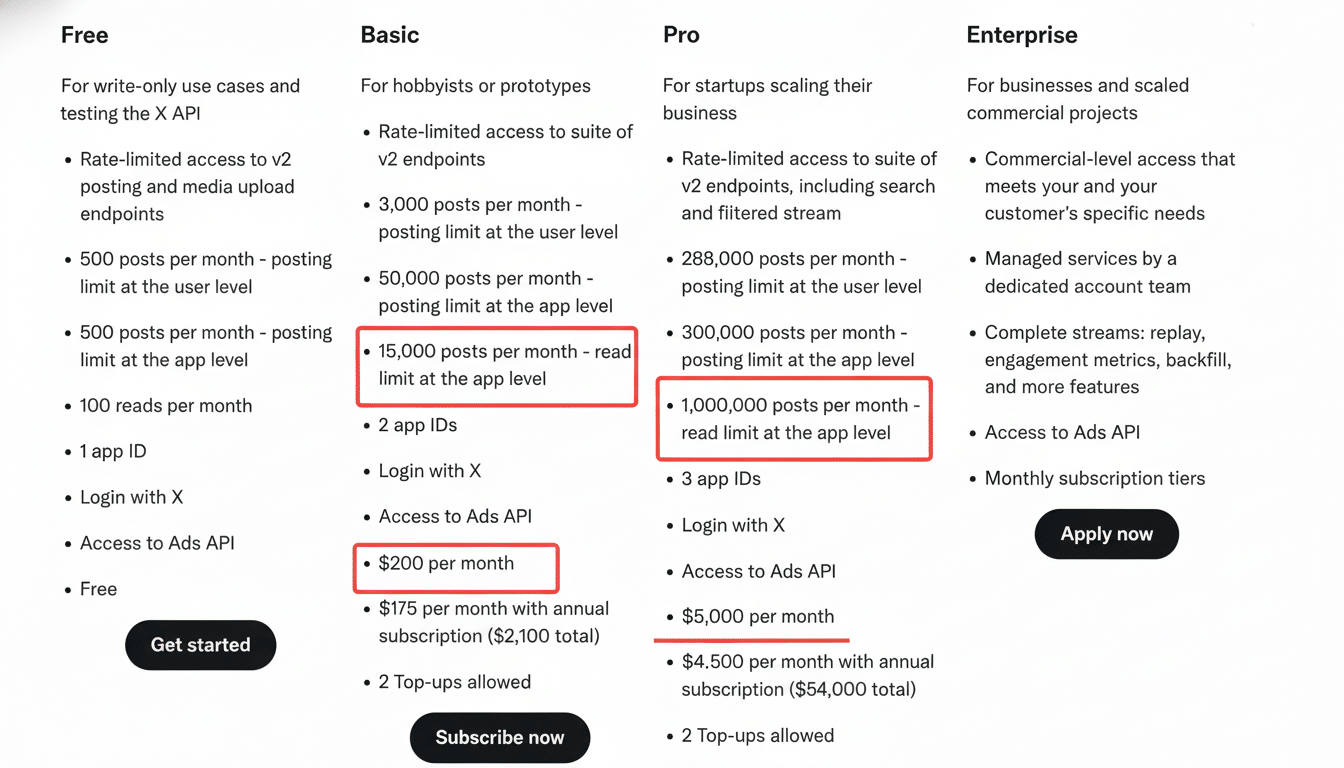X is experimenting with a pay-per-use model for its API, opening up beyond a closed beta that moved away from fixed cost tiers to offering metered access.
The company is asking more developers to apply, and those that are accepted will receive a $500 voucher to help enable experimentation with the new setup. It’s a significant pivot for the platform that has ping-ponged between open access and high flat fees, and it could reset how startups, researchers, and businesses plan to bet on X integrations.

What changes with the pay-per-use API model at X
Instead of a flat monthly price for a package of requests, what developers in the beta are seeing now is per-endpoint pricing. Reads, posting, direct messages, trends, and bookmarks are each individually chargeable. X also includes a built-in calculator so teams can model projected spend based on expected traffic and operations mix.
This is a practical pivot. For instance, read-heavy applications see orders of magnitude more calls than write-heavy tools. By charging operations differently, X can match fees with compute and moderation requirements, while developers receive more granular control over cost contributors. The tradeoff here is complexity: Budgeting is now sensitive to request composition, not just volume.
Why X is rethinking API access and pricing tiers
Over the past several years, X changed how it offers access to its API: It ended free tiers, blocked standard third-party clients, and introduced paid plans that quickly proved unworkable for many people financially. The entry-level plan jumped to $200 per month, a Pro tier landed at $5,000, and an Enterprise option would be anchored at $42,000 — and then there were top-up packs in case the usage needed some patching over.
Those changes stabilized the platform’s revenue from API consumers but hollowed out the ecosystem. Indie developers, academic labs, civic-tech groups, and newsrooms that used to build on X scaled back or turned off integrations. Shifting to a metered pricing scheme could bring some of them back, especially the teams with sporadic workloads or narrow use cases that simply never justified a loose wallet strap from month to month.
Who benefits under metered pricing, and who pays more
Pay-per-use works well for builders with low or bursty traffic: hackathon projects, newsroom bots that post infrequently, internal dashboards, and research tools that bundle periodic collection jobs together. These customers say they wanted to keep themselves from buying too much of an expensive plan that they rarely maxed out.
High-volume services may also have mixed success. Metered costs could be higher than previous flat fees if workloads were read-intensive or tied to costly endpoints. Predictability of budget becomes a worry, especially for user growth that can swing hourly, like at a startup. The general guidance is to define automated spend limits, notifications, and fallback decisions that fail-safe when cost boundaries are reached.
Importantly, it is not known whether the use-based model will continue alongside existing tiers or ultimately replace them. With both running, cost-conscious teams could choose predictability while experimental builders paid only for what they consumed.

Context from other platforms adopting metered pricing
The shift is a reflection of broader changes in developer infrastructure. Google Maps Platform pioneered pay-as-you-go pricing that disrupted the location services market. For years, cloud and communications providers such as AWS and Twilio have made their indelible mark with per-call billing, conditioning us to think of metered access by default when we pay for access to scalable APIs.
Social platforms, though, have a mixed history. Reddit’s turn toward paid API access shut down popular third-party clients and galvanized a lot of virulent reaction from developers and moderators alike. The takeaway: Monetization changes need to juggle platform sustainability while taking into account the ecosystem’s current ability to shoulder new costs, or else the community will shrink.
There are studies that support the broader trend. OpenView’s research on usage-based pricing is one indicator continuing to gain traction in software infrastructure, with customers and vendors both seeing a clearer correlation between price and value when metering aligns closely with customer outcomes. That alignment falls apart when pricing is opaque or essential endpoints come with unexpectedly high price tags.
What developers should watch in X’s metered API rollout
The headline is pricing granularity by endpoint, but the devil will be in the details of its implementation.
The questions are the usual:
- How X enforces rate limits when combined with per-call billing
- Whether there are bulk discounts or committed-use credits
- How sensitive actions like DMs are priced
- What kind of audit tools exist for cost attribution at the endpoint, user level, and feature level
Transparency will be as important as price. Docs, example workloads with cost breakdowns, and cost simulation tools available in developer dashboards are now table stakes. The $500 voucher is a clever encouragement to onboard, but trust will depend on whether real-world bills match the calculator and if support channels can work out surprises fast.
If metered access is done correctly, it could once again open the door to valuable integrations: lightweight customer service bots, accessibility tools, public-interest research projects, and newsroom pipelines that inform reporting. If not, it will become just another tax on innovation that only the biggest companies can pay. The beta, for now, is a welcome testing ground of whether X can price its API such that it rewards value creation and avoids punishing experimentation.

